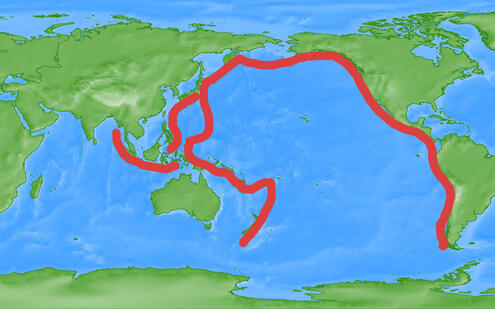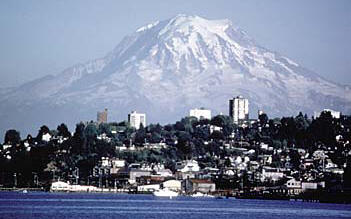POWER of PLATE TECTONICS
Explore how plate tectonics affect our planet.
Volcanoes
Some mountains are made of solid rock, like the Rocky Mountains or the Swiss Alps. But, some mountains are actually volcanoes.

The Ring of Fire is a large circle of explosive volcanoes around the Pacific Ocean. The circle is formed by the subduction of the Pacific Plate and some smaller plates under surrounding plates.
Volcanoes are vents, or openings in Earth's crust, that release ash, gases and steam, and hot liquid rock called lava. When the lava cools and hardens, it forms into the cone-shaped mountain we think of as a volcano. Most of the world's volcanoes are found around the edges of tectonic plates, both on land and in the oceans.
On land, volcanoes form when one tectonic plate moves under another. Usually a thin, heavy oceanic plate subducts, or moves under, a thicker continental plate. When this happens, the ocean plate sinks into the mantle.

The Mount Rainier volcano in Washington is considered "active." Volcanoes are classified as active (erupted recently), dormant (expected to erupt in the future), or extinct (not expected to erupt again).
Water trapped in the rocks in this plate gets squeezed out. This causes some of the rocks to melt. The melted rock, or magma, is lighter than the surrounding rock and rises up. This magma collects in magma chambers, but it is still miles below the surface.
When enough magma builds up in the magma chamber, it forces its way up to the surface and erupts, often causing volcanic eruptions.
In the ocean, volcanoes erupt along cracks that are opened in the ocean floor by the spreading of two plates called a mid-ocean ridge . Magma from Earth's upper mantle rises up to fill these cracks. As the lava cools, it forms new crust on the edges of the cracks. These mid-ocean ridges are actually long chains of underwater volcanoes that circle the planet like the seams on a baseball.
About 80 to 90 percent of all volcanic eruptions occur where the plates spread apart.
Image Credits:
Mount Rainier, courtesy of United States Geological Survey (USGS)




 Biodiversity
Biodiversity
 Brain
Brain
 Genetics
Genetics
 Marine BiOLogy
Marine BiOLogy
 MicrobiOLogy
MicrobiOLogy
 PaleontOLogy
PaleontOLogy
 ZoOLogy
ZoOLogy
 AnthropOLogy
AnthropOLogy
 ArchaeOLogy
ArchaeOLogy
 Astronomy
Astronomy
 Climate Change
Climate Change
 Earth
Earth
 Physics
Physics
 Water
Water
